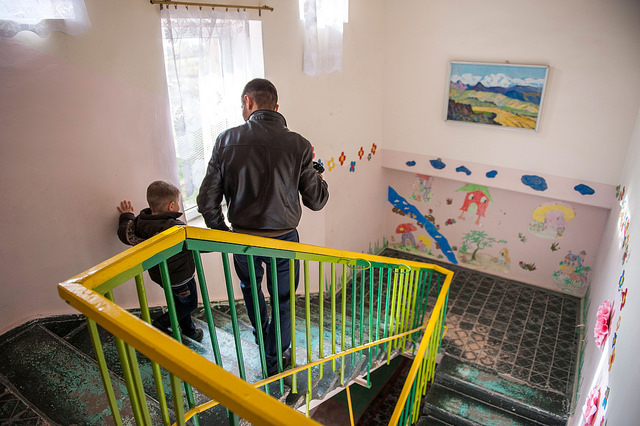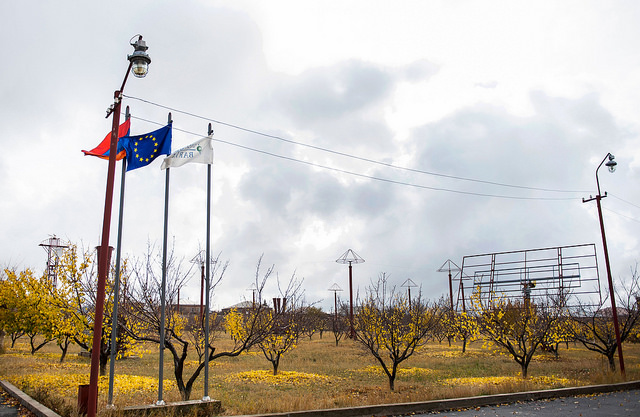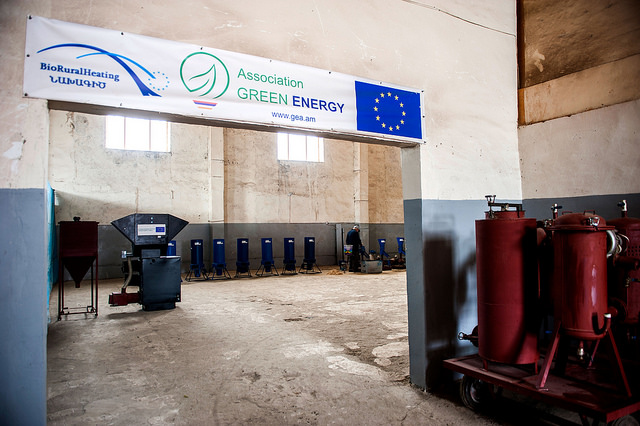Heating is still one of the unsolved problems of Armenia. Some communities, especially in remote regions, do not have a gas supply. Moreover, even when they do, people avoid using gas because of the high price, which is not affordable for the majority of the population. The Armenian mountains make it even harder for people to connect to a centralised gas supply system. As a result, people are not motivated to use natural gas, especially in villages.
Over recent years, the European Union (EU) has supported a large number of reforms and projects in Armenia. The purpose of a number of these projects has been to help Armenians become more energy efficient and reduce their energy consumption.
Green energy to keep children in Ashnak kindergarten warm in winter
In a big sunny room in a kindergarten in the village of Ashnak, children are sitting on small chairs and playing with toys. Five-year-old Tigran and four-year-olds Knarik, Ashot and Gevorg are gathered together around the same table. They are enthusiastically talking about their everyday lives at the kindergarten, about their friends and hobbies, when suddenly Knarik recalls, “We didn’t come to kindergarten in winter before. It was so cold in here.”
Before this year, the kindergarten in Ashnak had no heating and children had to spend winters at home, only returning in the spring. Thanks to the support of an EU project, the kindergarten now has a machine that transforms waste like dry leaves, sunflower seed and walnut shells, husks and sawdust into biomass fuel – pellets. The pellets are used by the biofuel heating system – a burner and boiler – to warm up the kindergarten premises, as well as water. This green energy not only keeps the children warm during winter, but also helps the kindergarten to save money and is also environmentally friendly.


The idea of coming to the kindergarten in winter thrills the children. Some of them are starting to tell stories about past winters. For instance, last year Tigran got a Santa Claus toy and excitedly says: “This year I can bring it to kindergarten and we can play with it together with my friends.” Gevorg prefers to play outdoors and exclaims that this year he can finally make snowballs with his kindergarten friends.


Simple solution for a complex problem
The kindergarten heating equipment was installed as part of the EU-funded BioRuralHeating project, in which the Ashnak was a partner.
The solution came about when the head of the community, Khachik Tonoyan, decided that having to close in winter needed to change. The community had always had problems with the gas supply being very expensive and debt was accumulating. The project provided a simple solution to these complex problems by way of affordable, environmentally-friendly green energy technologies.
Khachik underlines the huge financial benefits the project will have on the community’s budget: “If now we are paying €180 for heating per month, with this system we will be paying only €60. We will use available biomass, of which we have quite enough in the area. The kindergarten will stay open during winter and we will be able to ensure nice and comfortable conditions for our children. They won’t have to skip classes for four months anymore”.
BioRuralHeating makes six Armenian communities green
BioRuralHeating is an EU-project benefitting Armenia as part of the EU4Energy Initiative. The project helped to develop green energy in Armenia based on experiences from EU Member States, as well as neighbouring Georgia and Moldova, where similar EU-supported project were successfully implemented.
Six communities in Armenia became project partners: Khachik in Vayots Dzor, Mets Parni in Lori, Ashnak in Aragatsotn, Taperakan in Ararat, Lusadzor in Tavush, and Armavir. These communities were selected via a competition from communities across Armenia. One of the selection criteria was the availability of sufficient quantities of biomass to produce the fuel.
These efforts were reinforced by local awareness-raising campaigns organised by the BioRuralHeating project, explaining the benefits of green energy and how communities could access EU assistance.
Additionally, the Green Energy Association of Armenia was created as part of the project. This association focuses on developing green energy in Armenia and making the country more energy efficient and ecologically friendly by using biomass.
Biomass helps both the environment and the people
Ruben Gevorgyan, a craftsman from the Barva innovation centre, explains that biomass is generally produced out of plant waste. “We use straw, wood waste products, leaves and dried branches,” he says. “Generally, we produce 30-35 kilograms of biofuel per hour. We mostly sell the pellets to owners of greenhouses, which are numerous in this area. We help both the environment and the people.”
Barva innovation centre is an industrial partner of the BioRuralHeating project. The centre specialises in manufacturing energy efficiency equipment and biofuel. It has a showroom, which includes energy efficient equipment and explanations about the benefits they bring. There is also a demonstration greenhouse at the centre equipped with a biomass heater. Everything is interconnected so that residents and farmers from nearby communities can visit and get all the information they need about how to switch to renewable energy.


As a partner of the BioRuralHeating project, Barva played a significant role in testing the biomass heating systems. The centre also worked on developing so-called gasifier systems. When the pellets are burnt, they produce smoke, which is then filtered twice by a special machine – a gasifier. As a result of the filtering, a gas is produced that is very similar to natural gas. This gas can be burnt and used for heating. Gasifiers come in different sizes – they can be used both for personal and production needs.
With the support of the BioRuralHeating project, two gasifiers were provided to communities. One was installed in Ashnak and the other one at Barva.
The plan is to switch all villages lacking a gas supply to pellets and bring green energy into people’s houses. It will be both affordable for citizens and will have a positive impact on the environment.
Arthur Gasparyan from Barva explains that this method will be much more convenient for villagers: “Our villages have had the option of connecting to the gas supply system for 7-8 years, but only 20% of the population use it. The prices are so high that most of the villagers cannot afford to use gas. Also, because of the difficult terrain, it is very difficult and expensive to connect to the centralised gas supply system. For example, one consumer would have to pay almost €900 to get his house connected. People will be able to pay 3-5 times less for gas produced by the gasifiers and it will be accessible even in mountainous areas of Armenia.”
Biomass helps both the environment and the people
Ruben Gevorgyan, a craftsman from the Barva innovation centre, explains that biomass is generally produced out of plant waste. “We use straw, wood waste products, leaves and dried branches,” he says. “Generally, we produce 30-35 kilograms of biofuel per hour. We mostly sell the pellets to owners of greenhouses, which are numerous in this area. We help both the environment and the people.”
Barva innovation centre is an industrial partner of the BioRuralHeating project. The centre specialises in manufacturing energy efficiency equipment and biofuel. It has a showroom, which includes energy efficient equipment and explanations about the benefits they bring. There is also a demonstration greenhouse at the centre equipped with a biomass heater. Everything is interconnected so that residents and farmers from nearby communities can visit and get all the information they need about how to switch to renewable energy.
As a partner of the BioRuralHeating project, Barva played a significant role in testing the biomass heating systems. The centre also worked on developing so-called gasifier systems. When the pellets are burnt, they produce smoke, which is then filtered twice by a special machine – a gasifier. As a result of the filtering, a gas is produced that is very similar to natural gas. This gas can be burnt and used for heating. Gasifiers come in different sizes – they can be used both for personal and production needs.
With the support of the BioRuralHeating project, two gasifiers were provided to communities. One was installed in Ashnak and the other one at Barva.
The plan is to switch all villages lacking a gas supply to pellets and bring green energy into people’s houses. It will be both affordable for citizens and will have a positive impact on the environment.
Arthur Gasparyan from Barva explains that this method will be much more convenient for villagers: “Our villages have had the option of connecting to the gas supply system for 7-8 years, but only 20% of the population use it. The prices are so high that most of the villagers cannot afford to use gas. Also, because of the difficult terrain, it is very difficult and expensive to connect to the centralised gas supply system. For example, one consumer would have to pay almost €900 to get his house connected. People will be able to pay 3-5 times less for gas produced by the gasifiers and it will be accessible even in mountainous areas of Armenia.”


The BioRuralHeating project is a good example of the practical assistance that the EU is offering to Armenia in the area of green and affordable energy. The aim is not only to make the life of Armenians easier and more convenient, but also to make them eco-friendly and energy efficient. The success story of Ashnak village shows that the strategy of projects like BioRuralHeating is already having a positive effect.
This article has been produced with the assistance of the European Union in the framework of the EU4Energy Initiative. The contents are the sole responsibility of the author and can in no way be taken to reflect the views of the European Union.
Ami Chichakyan








































































